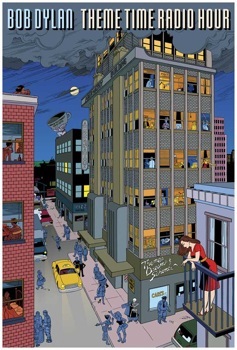Site informationRecent Blog Posts
Blog Roll
|
assignmentDylan's Theme Time Radio enters the visual realm
Submitted by Justin Tremel on Mon, 2007-10-29 19:32
Those of you who subscribe to XM satellite radio may have come across Bob Dylan's weekly radio show Theme Time Radio. Recently comic artist Jamie Hernandez created an imaginative promotional poster for the show. Boing Boing reader Simon Nielsen took Hernandez's poster one step futher and made a short movie tribute using Hernandez's artwork and the audio from Ellen Barkin's evocative voiceovers that open each episode of Theme Time Radio Hour. Nielsen writes: ‘Robot Chicken’ deconstructs ‘Law & Order’
Submitted by John Jones on Tue, 2007-09-04 15:50
When I teach writing, I like to occasionally give my students imitation exercises to point out the features of a particular text. Robot Chicken, Seth Green’s stop-motion-animation show, has provided a pretty funny video example of this practice (my favorite touch is when they bleep out the bad language). It would be interesting to assign this type of video exercise for students to familiarize them with video conventions. See the video here. Tags:
Proposal websitesNotes for the Instructor: This version of the proposal argument focuses on a realistic choice of topic that demonstrates the "think globally, act locally" principle. The goal is to encourage students to write their proposals as if their audience is made up of people with the power to solve the problem. Some student samples are included below. Instead of writing a traditional essay to make their proposals, students will create websites to explain and argue their claims. To implement this assignment, the instructor will need to relate this prompt to the content of the course (by specifying what type of prompt is appropriate) and determine exactly what format the website should take (that is, how many pages it should include, what type of layout is to be preferred, and what sort of content is appropriate). Assignment Description: Creating a website that makes a proposal argument Category: Individual project Goals: For this project, you will construct a proposal argument on a controversial issue of your choice. Your central claim must make a proposal, and it must be arguable. Additionally, you are to make your argument as though you are writing for an audience with the power to solve the problem. A proposal argument answers the question, "What should we do?," although you might argue against a proposed course of action instead. The final product will be a website designed and written to make this argument. Building a Proposal Argument:
After you've identified a problem, you'll want to think about a solution. Is it something we can live with? Or do we need to address it immediately? You'll need to consider a variety of solutions, including steps that might already have been taken. Once you've examined several options, you'll want to propose the solution that you think is best and give good reasons. Things you should take into consideration:
Finding a Topic:
Developing Your Content
Choosing an Audience For this project you will choose the best audience for your proposal. This audience might be an individual or group with the authority to enact your proposal. (You may need to do some research to determine who this is.) Or, you might choose an audience that is indirectly involved with the actual decision making. For example, you could aim to persuade a relevant group to attend a particular event or write their own letters to an authority suggesting a particular course of action. Be sure to construct the website so that this specific audience will find it persuasive. Along these lines, you'll need to organize your website to reach this audience and choose appropriate appeals, style, and tone. You will also need to think carefully about the kind of content (images, charts and graphs, links to other pages, etc.) that will strengthen your proposal. Choosing a Format: Your choice of audience will determine your writing style and the format of your web site. For example, your web site proposal might include links to other pages and an introductory page encouraging your audience to visit the site. To creat multiple pages within your web site, you will want to try breaking your argument into sections with clear headings and subheadings. Likewise, you might experiment with using bulleted lists, tables, and charts as appropriate. Grading:
Student Samples Proposal assignmentNotes for the Instructor: This proposal assignment offers visually-oriented alternatives to the traditional essay and gives students the opportunity to create a web site, a short film, or a PowerPoint presentation. Attached are two examples of PowerPoint presentations, a rough draft and a final draft that has been revised for aesthetic and persuasive appeal. To implement this assignment, the instructor will need to specify a more exact prompt and the specific guidelines necessary to complete the project (for example, the length of a short film [recommended: 5–10 minutes] or PowerPoint presentation [recommended: 20 minutes]), the number and type of sources to be used (the assignment currently requires a minimum of five), the grading specifications, and the due dates. Assignment Description: Creating a proposal argument Category: Individual project Goals: This project is designed give students practice in producing visual proposal arguments; to lead them to demonstrate facility with the tools of visual rhetoric; and to think critically and carefully about the relationship between aesthetics and arguments, or between visual rhetoric and persuasion. Students will research a specific proposal and create a web site, a PowerPoint Presentation, or a short film as the medium for presenting their proposal argument. The objective is to present a well thought-out proposal that offers a viable solution to an issue that interests you, and that identifies a specific plan of action for your reader. Tasks:
Guidelines:
Topic Proposals: Your topic proposal should include the following:
Rough Draft: Your web site or short film should be fairly well fleshed out, and although they may not have all of the content you plan to incorporate into the final product, they should be close to the completed stage. If you elect to do a PowerPoint presentation, you should have all of your slides set up (even if you plan to revise them), and you should also have a Word document summarizing what you plan to say about each slide. Grading: These projects will be graded for their visual as well as textual content; the visual component and presentation will account for 25% of your assignment grade, and the textual component will account for the remaining 75%. Be sure to include a bibliography (yes, even for short films). |
viz.
Visual Rhetoric - Visual Culture - Pedagogy
Site informationRecent Blog Posts
|
assignment |



Recent comments
2 years 29 weeks ago
2 years 44 weeks ago
2 years 44 weeks ago
2 years 50 weeks ago
3 years 4 weeks ago
3 years 4 weeks ago
3 years 4 weeks ago
3 years 6 weeks ago
3 years 6 weeks ago
3 years 6 weeks ago